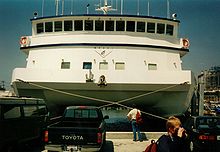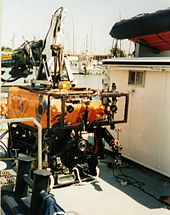Monterey Bay Aquarium Research Institute
The Monterey Bay Aquarium Research Institute (MBARI) is an oceanographic research institute located in Moss Landing on California's Pacific coast . The institute was established by the David and Lucile Packard Foundation as a private foundation and non-profit organization . After the Monterey Bay Aquarium was built in 1984 with the help of a donation from David Packard , the institute was founded in 1987 as the scientific part of the aquarium.
assignment
The mission is to achieve and maintain a leading position in oceanography and marine technologies in the world. This is to be achieved through the development of better tools and methods for scientific exploration of the deep oceans. MBARI emphasizes the balance between engineers and scientists as the basic principle of its actions. All MBARI activities must be characterized by excellence, innovation and vision. ( David Packard , MBARI founder)
Institute
Around 220 scientists, engineers, technicians and administrative and operating staff are employed at the institute. The Institute has an annual budget of about 47 million US dollars . Research is carried out both theoretically as well as application- and method-oriented, including in the areas of marine biology, marine chemistry, marine geology, physical oceanography and marine technologies. The focus is on the subject areas of molecular biology , bioluminescence , processes on the sea floor and in sea canyons as well as global climate change . Other focal points are in the operation of the Remotely Operated Vehicle , in the development of devices for chemical analysis in the ocean and in computer science . Due to its equipment, it is possible in the MBARI to carry out or improve your own developments. The MBARI and the Monterey Bay Aquarium are two separate institutes, but they work very closely together in science and education.
The location of the institute on Monterey Bay was chosen because the beginning of the Monterey Canyon is located here . This ocean canyon is about 153 km long and reaches depths of up to 3600 meters, so its dimensions are comparable to the Grand Canyon on land. Due to the prevailing flow conditions, many different biological communities could develop here over very short distances. In addition, the Cascadia subduction zone , which runs parallel to the coast, is easily accessible from the institute.
Research vessels
The institute has three research vessels at its disposal: the R / V Western Flyer , the R / V Point Lobos and the R / V Zephyr . Two of the ships are specially designed for the use of Remotely Operated Vehicles (ROV). The double hull ship ( catamaran ) Western Flyer is the basis for the ROV Doc Ricketts . This is launched in the middle of the ship and can operate at depths of up to four kilometers. The previous model, the ROV Tiburon , which was developed in MBARI in 1996, was decommissioned in 2009 after well over 3000 dives.
The ROV Ventana is stationed on the ship Point Lobos , which completed its first dive in 1988 and can work to a depth of 1.8 kilometers. As long as the ships are in the bay, a communication system can be used to receive the camera images from the ROV live in the institute.
The research vessel Zephyr is primarily used for deploying and retrieving autonomous underwater vehicles , moorings and other oceanographic equipment.
further activities
The institute has installed two networks in Monterey Bay and below the continental shelf . The control center of the Monterey Accelerated Research System (MARS) is supplied with electricity from land via a 52-kilometer deep-sea cable . Instruments that enable long-term observations on the ground or in the water column can be connected there at depths of around 900 meters. The data is sent directly to the institute via fiber optic cables . In the deep sea , near the end of Monterey Canyon, the Monterey Ocean Observing System (MOOS) was installed. The control center on the sea floor is supplied with electricity via a buoy on the sea surface, which is equipped with a solar system and satellite communication, and data exchange with the institute is enabled. With this system, among other things, the flow of particulate organic material on the deep sea floor can be measured over long periods of time.
Library
The MBARI includes the joint library of the MBARI and the Moss Landing Marine Laboratories (MLML) with a collection of around 15,000 monographs and around 120 regularly published journals. The library specializes in marine engineering and marine engineering. The library is only available to the public after registering with the MLML.
Web links
- Monterey Bay Aquarium Research Institute
- Joint library of the Monterey Bay Aquarium Research Institute and Moss Landing Marine Laboratories
Coordinates: 36 ° 48 ′ 6 ″ N , 121 ° 47 ′ 18 ″ W.



